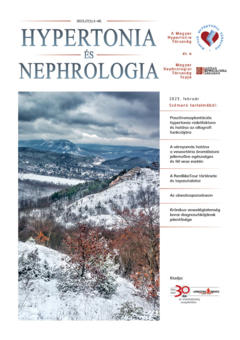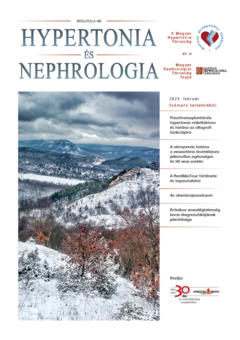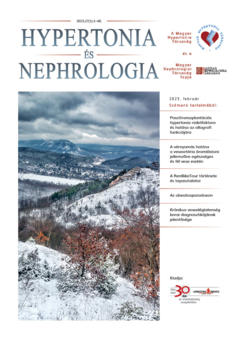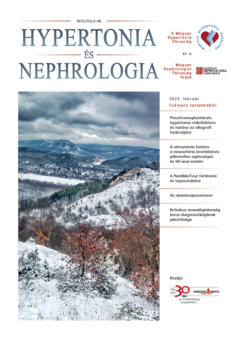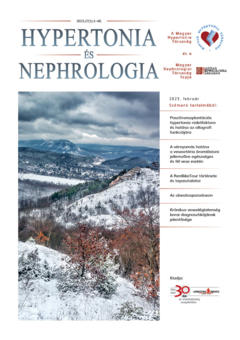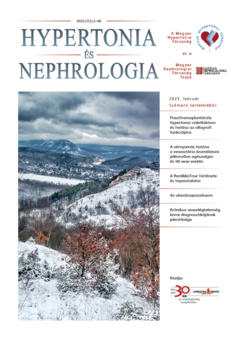The eLitMed.hu medical portal uses computer cookies for convenient operation. Detailed information can be found in the Cookie-policy.
Hypertension and nephrology - 2023;27(01)
Content
[Risk factors for post-transplant hypertension and its impact on graft function]
[Introduction: Cardiovascular diseases are the leading causes of death after kidney transplantation, one of the major risk factors of which is post transplant hypertension (PTHT), which is often unrecognized and therefore untreated. Material and methods: In this study, the incidence and risk factors of PTHT were examined. The effect of blood pressure on graft function. Results: The incidence of PTHT was 42%. Regarding the risk factors, no significant difference was revealed. PTHT was significantly higher in cyclosporine users (p=0.021), than in tacrolimus users. Significant differences were found in case of renal function: serum creatinine (p=0.024), urea (p=0.005), and eGFR (p=0.036) in patients with PTHT. Discussion: The harmful effect of newly developed hypertension after transplantation on the graft was seen after transplantation in renal function. Therefore, we consider it essential to monitor blood pressure regularly and to start antihypertensive therapy if necessary.]
[Effect of blood pressure on the flow characteristics of the renal artery in the case of healthy and single kidney condition]
[Changes in blood pressure may affect flow characteristics and thus the haemodynamics of the kidneys as well. This effect may be more explicit in the single kidney state. The in vivo unmeasurable flow characteristics can be effectively estimated by numerical flow simulation. The primary aim of this study was to demonstrate that hypertension and isolated systolic hypertension result in changes of the flow characteristics of the renal artery that are more pronounced in the single kidney condition. Methods: Right and left renal artery branching angles were measured retrospectively in vivo in a randomly selected group of patients. A series of numerical flow simulations were performed, healthy and single kidney models to measure the flow characteristics of the renal artery. Blood pressure was first gradually increased from 120/80 mmHg to 200/90 mmHg. Subsequently, the case of isolated systolic hypertension was simulated by gradually decreasing diastolic blood pressure to 200/50 mmHg. The output parameters of the simulation were the pressure, turbulent kinetic energy, velocity and volumetric flow at the outlets of the renal arteries. Results: The average of the renal artery branching angles was 78° on the left side and 66° on the right side. The simulation results showed that hypertension and isolated systolic hypertension consistently alter renal artery flow characteristics to a greater extent in the case of single kidney. Conclusions: The kidney can be damaged by higher pressures, and an increase in turbulence may lead to atherosclerosis in the renal artery branching. These characteristics are higher in the single kidney state; thus, it is more dangerous for the kidney. Flow velocity and volumetric flow are not significantly dependent on the single kidney state.]
[History and experiences of RenBikeTour]
[The RenBikeTour, a unique programme in global terms, is a very successful bicycle tour which is organised for people living with renal failure. It started off in 2013 and only halted during the Covid pandemic. The key to its success is the atmosphere in which the patients with renal failure can feel safe during the tour, where they can meet their companions, share their experiences about their disease and the dialysis, where they can meet post-transplant patients and acquire information from them regarding the transplantation, the struggles and the changed lifestyle that comes with it, where they can feel “healthy” again among friends, family, sympathizers and healthcare workers, where they can meet new friends, where they can relax in a controlled environment, all this for free with the help of patrons.]
[Obesity paradox. Is there a metabolic disadvantage that is advantage is certain situations?]
[There are many known factors that increase the risk of developing type 2 diabetes, cardiovascular diseases, and chronic kidney failure for patients both in terms of mortality and morbidity. One of the best known of these is obesity. A basic health goal is therefore the fight against obesity. However, there are test results that have proven better mortality and morbidity values in the case of a slight overweight compared to those with a healthy body weight. This is the obesity paradox. In the following article, we explore this concept based on some recent study results.]
[The importance of early diagnosis of chronic kidney failure]
[Chronic kidney disease (CKD) represents a significant public health problem, causing increased cardiovascular and other comorbidities, and mortality. It also causes a high healthcare expenditure. According to recent estimations in 2017 there were 697.5 millions CKD patients worldwide. The same publication estimates the number being 1.5 million patients in Hungary. The most prevalent diseases causing CKD are diabetes, prediabetes and hypertension. As CKD itself is relatively symptom free in early stages, early identification is important for guiding timely therapeutical interventions. This summary discusses the possibilities for early diagnosis and the importance of screening. The cardiovascular and renal outcomes are also discussed, the early diagnostic and therapeutic possibilities in CKD are also highlighted. We summarize the guidelines relevant for CKD screening and slowing progression.]
[Hungarian and international experiences of renal rehabilitation – aims to be achieved in Hungary]
[Progression of chronic kidney disease causes deterioration of the physical strength and functional ability in most renal patients, which limits their job opportunities, family and social life, and personal independence in the elderly population. Beside physical disability, both the patients and their family members bear severe psychosocial burden. All of these may be substantially alleviated by complex rehabilitation, providing physical training, physiotherapy, dietary, clinical pharmacological and psychosocial care. In this publication authors present the efficacy and cost effectiveness of the renal rehabilitation by briefly summarizing the results of international clinical experiences. Hungarian nephrologists’ initiatives and the actually available programs in rehabilitation have also been referred. Suggestions are given to develop collaboration of the nephrologists and rehabilitation specialists, to establish the nephrological-rehabilitation teamwork, aiming to elaborate the methodology and introduce renal rehabilitation program.]
[A case report of hypertensive encephalopathy]
[One consequence of rapid rise in blood pressure is the hypertensive encephalopathy (HE), which was proposed in 1928. Our aim is to raise awareness with help of our own case presentation to the importance of recognition and correct treatment of a not always benign disease HE. The general symptoms may be accompanied by disorders of consciousness, seizures and neurologic focal signs, causing several diseases with rapid rise in blood pressure. In the last century, the HE was recognised as one of the appearances of posterior reversible encephalopathy syndrome (PRES). The pathogenesis is still incompletely understood but researchers are agreed of two concepts the ”autoregulation breakthrough” and particularly in secunder hypertension the endothelial dysfunction. Our own clinical case is a good example of the above mentioned HE, a 26 years old female, who had atypical hemolytic uremic syndrome with rapidly evolving malignant hypertension, resulting in end stage renal disease. In addition to characteristic HE symptoms there were retinal hemorrhages, left arm paresis and cranial MRI showed PRES, which signs gradually disappeared due to hemodialysis, plasma exchange, antihypertensive and brain edema treatments. To sum up, the early diagnosis and treatment of HE is paramountly important because the disease can be potentially fatal, however in case of appropriate management it can be reversible and completely cured.]
1.
Clinical Neuroscience
Is there any difference in mortality rates of atrial fibrillation detected before or after ischemic stroke?2.
Clinical Neuroscience
Factors influencing the level of stigma in Parkinson’s disease in western Turkey3.
Clinical Neuroscience
Neuropathic pain and mood disorders in earthquake survivors with peripheral nerve injuries4.
Journal of Nursing Theory and Practice
[Correlations of Sarcopenia, Frailty, Falls and Social Isolation – A Literature Review in the Light of Swedish Statistics]5.
Clinical Neuroscience
[Comparison of pain intensity measurements among patients with low-back pain]1.
Clinical Neuroscience Proceedings
[A Magyar Stroke Társaság XVIII. Kongresszusa és a Magyar Neuroszonológiai Társaság XV. Konferenciája. Absztraktfüzet]2.
3.
Journal of Nursing Theory and Practice
[A selection of the entries submitted to the literary contest "Honorable mission: the joys and challenges of our profession" ]4.
Journal of Nursing Theory and Practice
[End of Life and Palliative Care of Newborns in the Nursing Context]5.
Journal of Nursing Theory and Practice
[Aspects of Occupational Health Nursing for Incurable Patients ]



